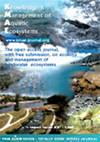Nutrient addition delivers growth advantage to Hydrilla verticillata over Vallisneria natans: a mesocosm study
IF 1.7
3区 环境科学与生态学
Q3 FISHERIES
引用次数: 5
Abstract
Nutrient availability can affect both the morphology and the nutrient uptake strategies of submerged macrophytes, with different species responding differently to increases in nutrient levels. A 98-day mesocosm experiment was conducted to investigate the responses of co-cultured Hydrilla verticillata and Vallisneria natans to nutrient enrichments of 3.0 mg N/(L ∙ week) and 0.2 mg P/(L week), mimicking external loading. Water samples were collected every 2 weeks for measuring nutrient and total suspended solid (TSS) concentrations and biomass of phytoplankton (Chl a). Dry biomasses of roots and shoots of both species were measured at the end of the experiment. Results showed that under nutrient-enriched conditions, both species reduced the ratio of root to shoot growth and increased nutrient storage per unit of biomass. However, only H. verticillata exhibited enhanced growth and nutrient storage, as well as a lower root: shoot ratio and greater shoot biomass than seen in Vallisneria. Our findings demonstrate that nutrient enrichment of the water column can invoke morphological plasticity in both H. verticillata and V. natans, but when both species grow together, the growth advantage goes to the former.营养物质的添加提供了水螅在水草上的生长优势:一项中观研究
养分有效性可以影响沉水植物的形态和养分吸收策略,不同物种对养分水平的增加有不同的反应。采用模拟体外负荷的方法,研究了共培养水蛭和水藻对3.0 mg N/(L∙周)和0.2 mg P/(L周)的营养物质的响应。每2周采集水样,测定营养物、总悬浮固体(TSS)浓度和浮游植物生物量(Chl a)。试验结束时测定两种植物根和芽的干生物量。结果表明,在营养丰富的条件下,两种植物的根与梢生长比均降低,单位生物量养分储量增加。但与缬草相比,只有水蛭草的生长和养分储量有所增加,根冠比较低,茎部生物量较大。研究结果表明,水柱的营养富集可以引起水蛭和水蛭的形态可塑性,但当水蛭和水蛭共同生长时,前者具有生长优势。
本文章由计算机程序翻译,如有差异,请以英文原文为准。
求助全文
约1分钟内获得全文
求助全文
来源期刊

Knowledge and Management of Aquatic Ecosystems
环境科学-海洋与淡水生物学
CiteScore
3.70
自引率
5.60%
发文量
22
审稿时长
>12 weeks
期刊介绍:
Knowledge and Management of Aquatic Ecosystems (KMAE-Bulletin Français de la Pêche et de la Pisciculture since 1928) serves as a foundation for scientific advice across the broad spectrum of management and conservation issues related to freshwater ecosystems.
The journal publishes articles, short communications, reviews, comments and replies that contribute to a scientific understanding of freshwater ecosystems and the impact of human activities upon these systems. Its scope includes economic, social, and public administration studies, in so far as they are directly concerned with the management of freshwater ecosystems (e.g. European Water Framework Directive, USA Clean Water Act, Canadian Water Quality Guidelines, …) and prove of general interest to freshwater specialists. Papers on insular freshwater ecosystems and on transitional waters are welcome. KMAE is not a preferred journal for taxonomical, physiological, biological, toxicological studies, unless a clear link to ecological aspects can be established. Articles with a very descriptive content can be accepted if they are part of a broader ecological context.
 求助内容:
求助内容: 应助结果提醒方式:
应助结果提醒方式:


